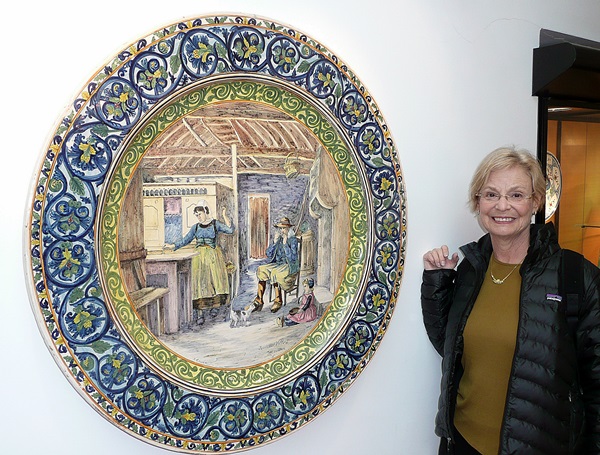Friday, May 10, 2013 Quimper
In some ways, at least for Joyce, today was the end of a
pilgrimage, and it wasn’t what we came for.
The museum dedicated to Quimper faience (pottery) is adjacent
to the factory where the pottery is made.
According to the web site and guide books, tours are offered three times
a day, the first at 11:00 AM, Monday through Friday. We’re here four nights and three days (five
days and four nights in travel agent terms).
As Wednesday and Thursday were holidays and the weekend begins tomorrow,
today was the only day we had to see the production.
We arrived at the museum at 10:00, its opening time. It’s small but has an astonishing collection
of historical Quimper pottery. The
subjects range all over the place, and many artists are featured in the
collection. Among the more interesting
pieces (at least to us) was this depiction of the death of Emile Zola (of J’Accuse
fame during the Dreyfus affair). The
word “depotoir” translates as garbage dump or the like.
After seeing the museum we went around the corner to the
factory/store. Asked about the
tour? The factory is not operating
today. Yes, hit by the five-day weekend
as I’ve outlined before. Of course the
shop is open:
We wandered this lovely city for most of the day, and came
across an interesting building. In this
city of stone buildings, where everything matches, this art-deco (?) building
with a giant “KODAK” on it was shuttered tightly. It’s sort of amusing to try to make a story
out of this, but ultimately, whatever the story is, it’s sad.
Finally, there are small gardens everywhere which are
beautifully cared for. In this one, a
poor soul with terrible kyphosis, obviously from osteoporosis due to his
smoking, is getting a lecture:
Tomorrow off to the nearby towns of Concarneau and Pont-Aven.








That Kodak building is perhaps not as disorienting as the "Institute Dentaire George Eastman" in Paris (on the Rue George Eastman!).
ReplyDeleteOuch--sorry you couldn't go on the factory tour....
ReplyDeleteBut how amazing to see those various items in the museum.
Did you have a sense of how the present-day wares compare to ones from the past? In quality, but also in style: are they introducing new patterns every few years, say? Do the current plates and cups have modern-day teenagers on them, with skateboards or motorcycles, in place of the primly clad young folk of the past?
Ralph
The photo of the Kodak building still puzzled me this morning, so I typed "Quimper Kodak" into Wikipedia and came up with this:
ReplyDelete==
Olier Mordrel (1901-85). ....
Throughout this period Mordrel was working as an architect. He created a number of buildings in Quimper which were the most advanced examples of modern architecture in the city, adopting the Streamline Moderne style. The most important of these is the Ty-Kodak building at the new-town area of cité Kerguelen. It has been described as "the most original and much the most beautiful" of modern buildings in the city.[1] It was constructed in 1933. The building has a wrap-around structure comparable to work by Le Corbusier, and alternates smooth white surface with blue tiling. According to the architectural critic Daniel Le Couedic, the "gentle sweep" of the broad white bands around the corner is contrasted dramatically with the strong angular and stabilising vertical structures of the windows.[2] It is signed with the architect's name on the boulevard facade.
==
Acc. to this article (which of course may have a variety of flaws, as often with Wikipedia), Mordrel was one of the most active Breton separatists, collaborated with the Nazis and the Vichy government (only to find that they didn't let Brittany break off from France, either), fled France after WW II, was sentenced to death in absentia in 1946, spent most of his last decades in hiding in Francoist Spain, finally returned to France incognito.
The article doesn't explain the phrase Ty-Kodak.
"The article doesn't explain the phrase Ty-Kodak."
ReplyDeleteWell, there's a photographer-CEO of a modeling agency who styles himself "Ty Kodak," but I'm pretty sure that's a coincidence.
Some research indicates that the Breton language is similar to several other Celtic languages, including Welsh. Google translate says that in Welsh, Ty Kodak means Kodak House.
And on the signs in the Breton language, "Hotel de Ville" is "Ti-Ker".
ReplyDelete